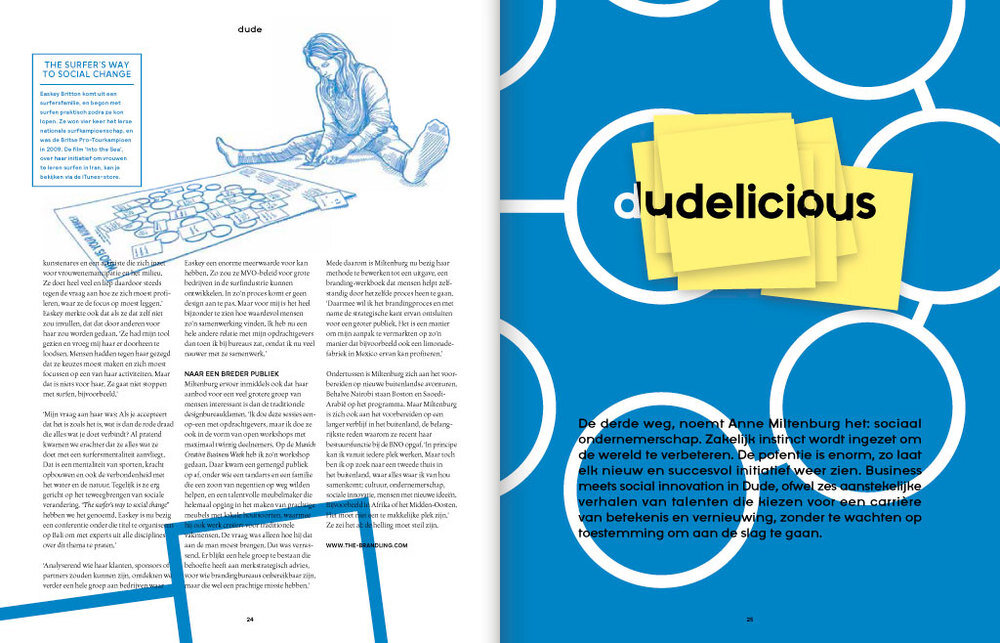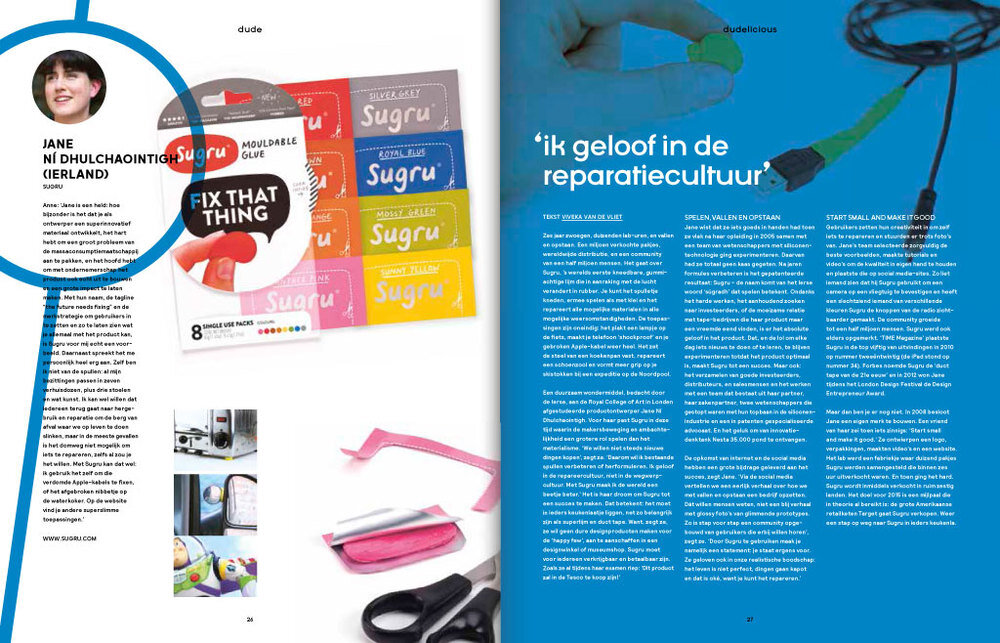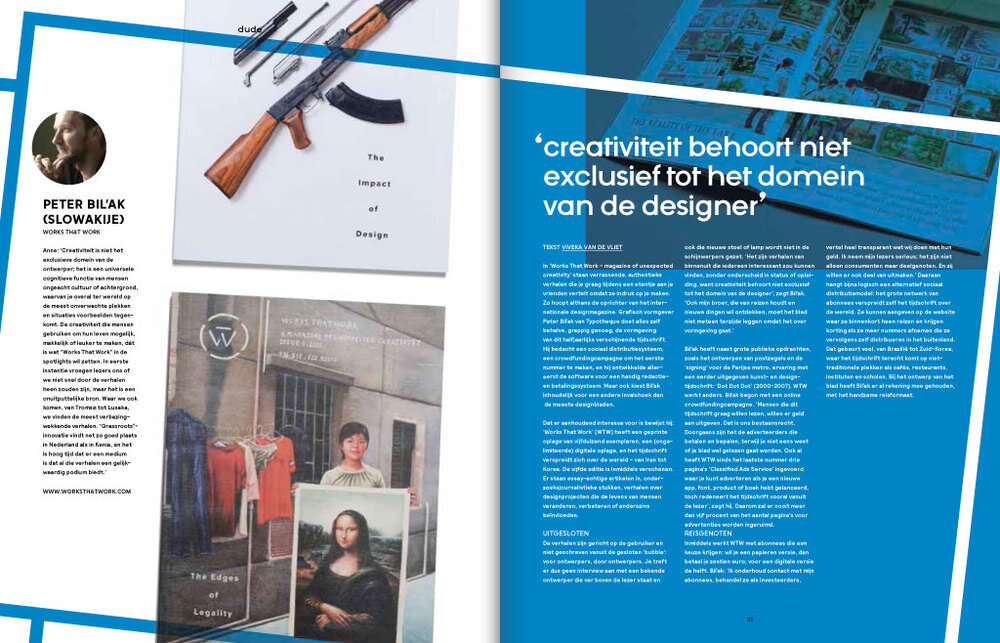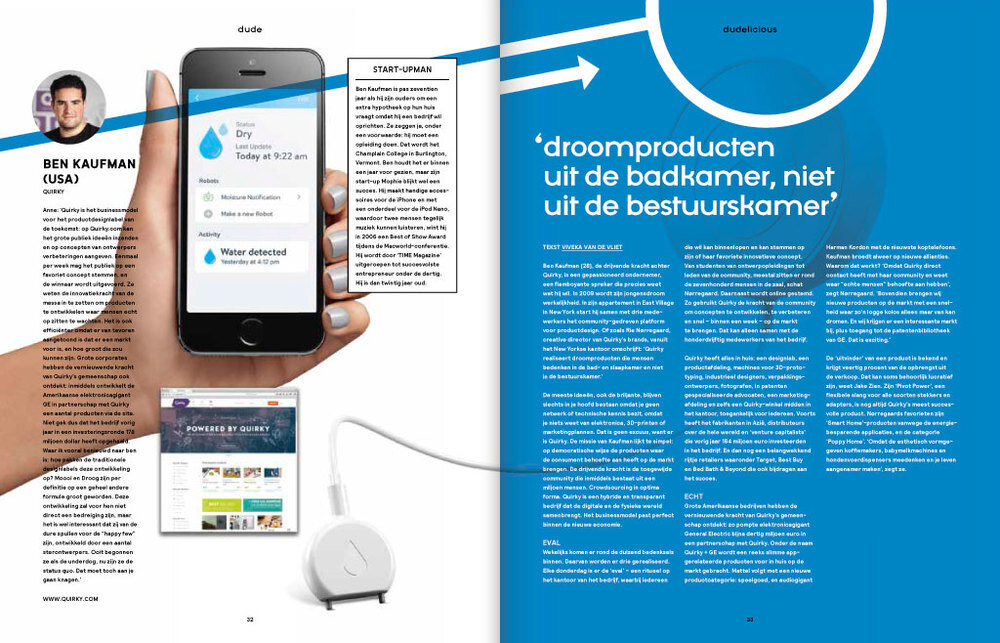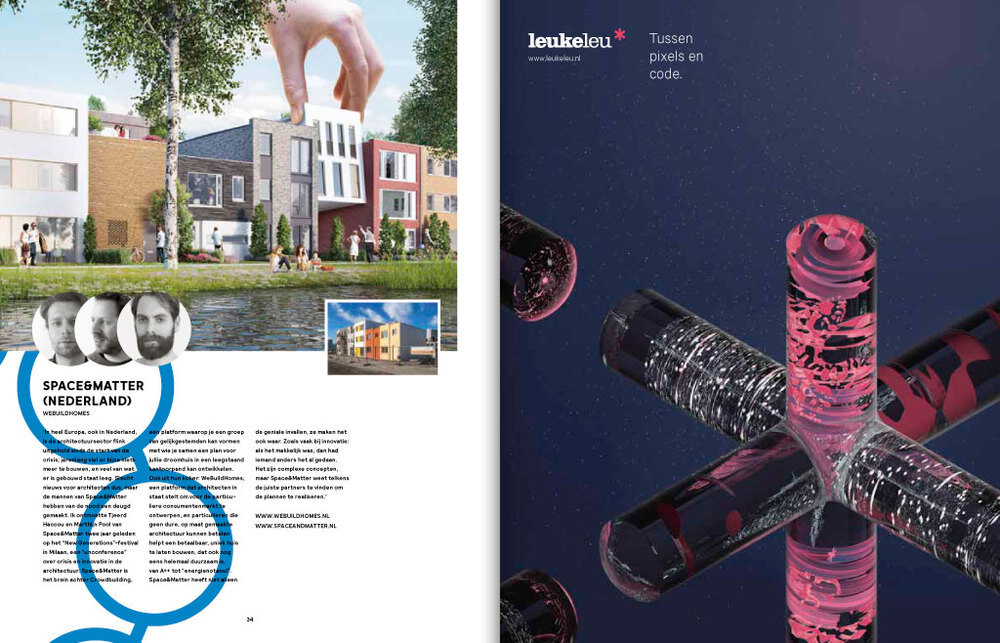Anne is the face of Dude this month
Update 2021: This article was written before our rebrand from The Brandling to Brand The Change.
This summer, Anne has the honour of being the guest editor and cover subject of Dude, the Dutch Designers magazine. The interview is available in English below, and in Dutch as a PDF. Interview by Bas van Lier, photography Ivo van der Bent.
ANNE MILTENBURG (1981)
After high school Anne lived and worked in Australia and the US. She returned to the Netherlands to study graphic design at the Royal Academy of Art in The Hague, and went on to work for Studio Dumbar Rotterdam, Lava, and Studio Dumbar Korea, won a European Design Award, an ADCN Lamp (Dutch Art Directors Club Award), and was a finalist at the Chaumont Festival. She has free-lanced for Interbrand, Meanwhile and Silo, taught, spent four years as a Dutch Design Awards scout, was a BNO board member for three years, and writes for a number of publications, including 'Eye', 'WorksThatWork' and 'Open Manifesto'. In 2013 she founded Designistan and, in 2014, The Brandling. Anne's home base is The Hague.
Main interview
‘Where’s the steepest climb and how can I create the greatest value for myself and others?’ This is the question that drives Anne Miltenburg’s professional development. After a fast paced career working with various design agencies she became independent in 2012. Miltenburg now supports 'changemakers' with strategy and branding across the globe under the banner of The Brandling. ‘I love design, creativity, but also writing and the business side. I’ve now found a way to tie all those loose ends together’.
‘It’s the trinity of business, society and design that I enjoy most’
‘When I look at you I see a child that yearns to achieve but can’t quite succeed yet, so resorts to shrieking,’ Tom Dorresteijn, Director of Studio Dumbar, once said to Anne Miltenburg when, at just 27, she was already on the studio’s management team. He was right, Miltenburg says six years later. ‘I believe that I’ve since grown into my ambition and that frustration over my inability to achieve my goals has subsided. The dynamic has changed, thanks partly to this type of positive critical feedback on my personal development.’
A development that, following her training, surged forward with an unstoppable, rocket-like force. Just ten years ago Miltenburg graduated as a graphic designer at the Royal Academy in The Hague with a project on HIV/AIDS, for which she spent three months in Mali. Afterwards she joined Studio Dumbar where she rapidly rose to senior designer and, in 2008, became a member of the management team. Less than a year later she moved to Lava, where the challenge of helping set up OrientationLab in Kuwait - a collaboration between Lava, the Iranian designer, Reza Abedini, and a local party - beckoned. When that initiative stalled due to the local party ultimately pulling out, she was offered the opportunity to further hone her strategic skills as strategist at Lava.
That is until Dumbar came back with an offer she couldn’t refuse: six months in Seoul to lay the foundations for a new Studio Dumbar branch. Once back home, she became independent. As a freelancer she fulfilled the role of creative director at Interbrand for almost a year, but has since worked as an independent brand developer in interchanging teams all over the world. It is this role that suits her best.
‘I'm really glad that I became independent,’ she says. ‘As part of a company you’re largely busy with achieving someone else’s goals, rather than your own. After Korea the question that rose overridingly from within was: What do I want?’ To figure that out she pursued a two-week summer course in design writing and research at the School of Visual Arts in New York and last year enrolled at THNK, The Amsterdam School for Creative Leadership. A recurring theme, she’s noticed, is the question: ‘Where’s the steepest climb and how can I create the greatest value for myself and others?’
The present answer is The Brandling, the banner under which Miltenburg currently supports changemakers in strategy and branding on location across the globe. On the side, she collaborates with WorksThatWork, a magazine about the impact of design by Peter Bil’ak, has developed a course on creative entrepreneurship for the Master Design course at the Willem de Kooning Academy, launched Designistan, a platform for content at the crossroads of society and design, and was a member of the BNO board of directors for just shy of three years.
Travelling brand developer
Miltenburg gets her social conscience, which runs like a thread through all of her activities, from her mother. Her decisiveness too. ‘My mother put her left wing ideals into practice through her wallet, by refusing to buy oranges from South Africa during the Apartheid regime era for example. She began her working life in a shop and, by the time she retired, had her own store of some twenty thousand square meters. My father is an historian; from him I inherited my more contemplative side. If he sees a beautiful vase, he can tell you all about it, whilst my mother would immediately wonder how many she could sell. I benefit from both traits and it is this trinity of business, society and design that I enjoy most.’
She recently underwent a period of profound self-examination in order to determine which business model would suit her best. ‘A year ago I started at THNK with the intention of developing a new business model, a new way of running my studio. In particular I had expected to gain a significant amount of business advice. But I soon realized that you can’t build a business model if you haven’t yet established what makes you happy. So I started to ask myself: What would my ideal working week look like? With whom do I want to work, where do I want to be, what do I want do?’
‘To begin with I established that I wanted to be able to travel a lot. For me that’s a basic prerequisite. Not going on holiday, but collaborating in earnest with people from other cultures. Upon analyzing my client base and the people with whom I preferred to work, I discovered that I identified most with those who wished to change the status quo, such as education, health or environmental protection. That's the group I feel most connected to and where I can add the greatest value. Because they must frame clearly to the world what they do, who they’re doing it for and what the added value is.’
‘Time is on my side’
Since September Miltenburg has travelled the world as a brand developer under the banner of The Brandling. In the last six months she has given workshops to entrepreneurs in a local co-working space in Tunisia, guided a start-up that harnesses IT technology for the protection of wildlife in Zambia, helped a surfing scientist to determine her identity and strategy in Ireland, and was actively involved with a school that prepares women for working life in Saudi Arabia. For the school she developed an instrument that enables female participants to identify who they are, what they can achieve and what they stand for - in essence, a branding tool. In June, Miltenburg travelled back to Nairobi to pilot the Brand Thinking for Changemakers curriculum, which she created for the Amani Institute, a school for social entrepreneurship. The curriculum teaches students what branding and brand strategy entails and how they can harness it to achieve their social objectives.
Binary thinking is over
‘Time is on my side’ confirms Miltenburg. ‘People now understand that social entrepreneurship is a kind of third way that offers lots of potential. Previously, NGOs wanted nothing to do with the business world. And, for “big business”, social or environmental goals often stood in the way of financial performance. I strongly believe that they need each other. The social sector realizes that the scale, strategic thinking and impact of the business world can be extremely valuable. And business has discovered that progress cannot be made without a genuine connection to society. I hope, of course, that this creates a new status quo for both, and I believe that branding can play a major role in successfully developing that third path and creating real impact for the wider public.’
It's also a generational thing, believes Miltenburg. The separation between socio-cultural and commercial worlds has only endured so long because people grew up with such black-and-white thinking. Miltenburg knows from personal experience that, even at design agencies, entrepreneurship and business motives have long been taboo. ‘Design agencies didn’t consider the business side as part of the creative process. Despite the fact that the conditions you create to perform your work can also be approached in an extremely creative way. That’s an important aspect of your enterprise and one from which you can derive a tremendous amount of enjoyment.’
Now that the economy is changing so dramatically and entire markets have been undermined, everyone is being forced to re-orientate and leave ‘binary thinking’ behind. ‘For this you require a specific type of hybrid talent’, says Miltenburg. ‘I trained as a designer, but I'm not your typical designer. I'm at my best when combining thinking with making. For an agency you’re either a strategist or a designer. That might well have changed, but in the existing context I couldn’t be myself. I am a great generalist. I love design, creativity, but also writing and the business side. I’ve now found a way to tie all those loose ends together and I'm extremely fortunate to be in the position to have been able to make the time to figure it out.’
The Miltenburg Method
Design might largely be an intuitive activity, however, Miltenburg goes about her work in an extremely methodical manner. For the development of brand strategies Miltenburg has developed a brand strategy canvas: a guiding model that allows her to map out answers to key questions about the person, company or brand that is the subject of the assignment, on large posters during brainstorming sessions with the client. To help them find the answers, the client is fired a barrage of questions about their personal mission, values nd goals and their intended audience. ‘This model helps you to jointly formulate your proposition in a relatively short space of time, so that you can subsequently look at how and who you’re going to communicate it to. Using this model, we can determine what products and services we’re going to develop, which tools we’ll require, where you’ll find us, whether or not we’ll organize events ourselves, which partners we’ll involve, and what type of people we’ll need. All elements that ultimately determine the impact of the person or brand.’
‘We need more hybrid talent'
Most of the clients with whom Miltenburg enters into this process are still at the start of their venture and searching for a business model. Just like social designer and educator, Emer Beamer, former co-founder of Butterfly Works. Beamer collaborated with Miltenburg in the initial set up of Unexpect, an organization aimed at stimulating the natural creativity of children for the resolution of societal problems. Her mission was to see her teaching method, in which children from seven to fourteen years of age use new technology for designing solutions for a better world, implemented in schools across the globe.
GLOBAL CHILDREN’S
DESIGN-A-THON
In Berlin, Dublin, Rio, Nairobi and Amsterdam children are busy designing solutions for their cities: from mobility and the environment to energy and security. Emer Beamer’s design method helps children to step through the design process, from the initial signaling of the problem, to the development of a solution, the design of the prototype, and the presentation to the public.
‘After the branding for Unexpect was rolled out we realized that we’d never receive attention for the story on the merit of the new business alone. We needed to create momentum and, to this end, the Global Children's Design-A-Thon was conceived. This was a day during which children in Amsterdam, Dublin, Berlin, Rio de Janeiro and Nairobi simultaneously designed solutions for better cities. At the end of the day they presented these solutions to one another via Skype. It was not merely an attention grabber; it was also an excellent way of distributing the methodology around the world. So it was really nice when the story ended up, totally according to plan, at Fast Company.’ At the end of April Unexpect launched its next step - the Design-A-Thon School platform for spreading the methodology worldwide.
Surfing scientist
Meanwhile the Miltenburg method has proved invaluable for a more personal type of branding. Which is precisely why champion Irish surfer, Easkey Britton, called Miltenburg for help. ‘As well as a surfer she’s also an environmental scientist, an artist and an activist committed to the empowerment of women and the environment. She does a lot and thus constantly bumped into the question of how best to profile herself, where to put her focus.’ Easkey also noticed that if she didn’t position herself, then others would do it for her. ‘She had seen my tool and asked me to guide her through it. People had told her that she had to make choices and that she must focus on one of her activities. But that’s not for her. She’s not going to give up surfing for example.’
The surfer’s way to social change
Easkey Britton comes from a family of surfers, and began surfing almost as soon as she could walk. She won the Irish national surfing championships four times, and was British Pro-Tour Champion in 2009. The film, 'Into the Sea', about her initiative to teach women in Iran to surf, can be viewed via the iTunes store.
‘My question to her was: If you accept that it is what it is, then what’s the common thread that binds all that you do? Whilst talking we discovered that she approaches everything with a surfers mentality. That’s a sports mentality, a strength building mentality, with a pervasive connection to water and nature. At the same time she’s also highly focused on instigating social change. “The surfer’s way to social change” we called it. Easkey is now busy organizing a conference of the same name in Bali, to talk with experts from all disciplines on this very topic.’
‘When analyzing her potential customers, sponsors or partners, we uncovered an entire group of businesses for whom Easkey could be of enormous benefit. She could develop a CSR policy for large enterprises within the surfing industry for example. Design doesn’t feature in such a process. Yet for me it’s still fascinating to see just how much people value such cooperation. I now have a totally different relationship with my clients than I did when I worked for agencies, because I collaborate with them much more closely now.’
The road to a wider audience
Miltenburg has meanwhile observed that her offering is of interest to a wider group of people than merely traditional design agency clients. ‘I not only conduct client sessions one-on-one; but also in the form of open workshops, with a maximum of twenty participants. I held just such a workshop at the Munich Creative Business Week. The turnout was a mixed crowd, including a dentist, a family who wanted to help their nineteen-year-old son on his way, and a talented cabinet maker who was completely absorbed in the manufacture of exquisite pieces of furniture made from local wood, which also resulted in him generating work for traditional craftsmen. The only question was how could he bring this to the attention of a wider audience. It was surprising. Apparently there was this entire group of people for whom branding agencies were quite out of reach, but who still required brand strategy advice for their worthwhile mission.’
Alf Khair Foundation
Women in Saudi Arabia have been allowed to work in a limited number of sectors for two years. Their protected lives, however, have resulted in a skillset that’s insufficient for the workplace, irrespective of their education. The Educational Institute at the Alf Khair Foundation prepares women for a career. The Brandling developed a set of tailor-made tools that empower female participants to consciously create and attract potential employers.
It’s partly because of this that Miltenburg is now busy composing her method into a publication, a branding-workbook that helps people to independently step through the same process. ‘With this I want to unlock the branding process, and in particular the strategic side, for a wider audience. It is a way of marketing my approach so that it can also benefit a lemonade factory in Mexico for example.’
In the meantime Miltenburg is preparing herself for fresh foreign adventures. In addition to Nairobi, Boston and Saudi Arabia are already on the agenda. But Miltenburg is now also readying herself for a longer foray abroad, the main reason she recently gave up her management position at the BNO. ‘In principle I can work from any location. But I'm still looking for a second home abroad, somewhere everything I love comes together: culture, entrepreneurship, social innovation, people with new ideas. Such as Africa or the Middle East for example. It can’t be a place that is too easy.’ She said it before: the climb must be steep.
A board must act like a think tank
Anne Miltenburg sat on the BNO board of directors for almost three years. Now that she’s leaving she reflects: ‘The BNO association is extremely well organized; it’s formed of professionals who can account for the majority of administrative and organizational matters themselves. The current board, including Gert Franke who’ll take my place, must immerse itself in the long-term vision and fundamental questions that the design sector, and thus the BNO, is confronting. A board must act like a think tank, to develop active responses to the question of what a professional organization in 2015 should look like. Now more than ever, it’s incredibly beneficial to form a sort of community that stands up for its own interests, and shares knowledge and values. If we could start afresh today, what would a professional organization for designers look like? Set those masterminds in general management to work on this.’
The third way, Anne Miltenburg calls it: social entrepreneurship. Business instinct that’s harnessed to improve the world. The potential is enormous, as each new and successful initiative repeatedly shows. Business meets social innovation in Dude, in six arresting stories about talented individuals who choose for a career with meaning and renewal, without waiting for permission to make a start. Featuring: Sugru, Quirky, WorksThatWork, Space&Matter, Mothership and Oliberté.

